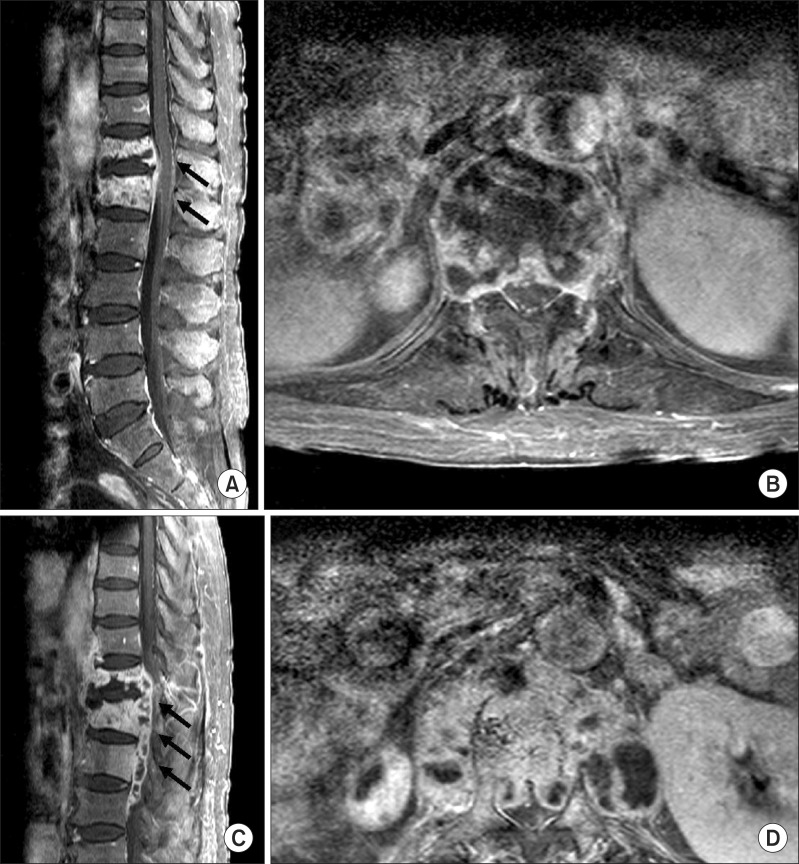Ann Rehabil Med.
2014 Jun;38(3):405-409. 10.5535/arm.2014.38.3.405.
Paralysis Developing as a Paradoxical Response During the Treatment for Tuberculous Spondylitis: A Case Report
- Affiliations
-
- 1Department of Rehabilitation Medicine, Seoul National University College of Medicine, Seoul, Korea. hyungik1@snu.ac.kr
- 2Department of Rehabilitation Medicine, Seoul National University Bundang Hospital, Seongnam, Korea.
- KMID: 2165761
- DOI: http://doi.org/10.5535/arm.2014.38.3.405
Abstract
- It can be difficult for clinicians to distinguish a paradoxical response to antituberculous therapy, worsening of an existing lesion despite adequate treatment, treatment failure, and drug resistance. We report a case of a 69-year-old woman who experienced bilateral lower extremity paralysis secondary to a paradoxical response. She had been suffering for 1 month from low back pain, due to tuberculous spondylitis. Her low back pain improved after antituberculous therapy. The low back pain, however, reappeared 2 months after treatment, accompanied by newly developed lower extremity weakness. Imaging studies showed an increased extent of her previous lesions. Consequently, the patient underwent a vertebral corpectomy with interbody fusion of the thoracolumbar spine. Histopathological examination showed chronic inflamed granulation tissue with no microorganisms. Although the antituberculous medication was not changed, the patient's symptoms and signs, including the paralysis, resolved after surgery.
Keyword
MeSH Terms
Figure
Cited by 1 articles
-
Paralysis Developing as a Paradoxical Response During Treatment for Tuberculous Spondylitis
Safak Ekinci, Faruk Akyildiz, Yavuz Poyrazoglu, Samet Verim
Ann Rehabil Med. 2015;39(2):327-328. doi: 10.5535/arm.2015.39.2.327.
Reference
-
1. Garg RK, Somvanshi DS. Spinal tuberculosis: a review. J Spinal Cord Med. 2011; 34:440–454. PMID: 22118251.
Article2. Cheng VC, Ho PL, Lee RA, Chan KS, Chan KK, Woo PC, et al. Clinical spectrum of paradoxical deterioration during antituberculosis therapy in non-HIV-infected patients. Eur J Clin Microbiol Infect Dis. 2002; 21:803–809. PMID: 12461590.
Article3. Cheng VC, Yam WC, Woo PC, Lau SK, Hung IF, Wong SP, et al. Risk factors for development of paradoxical response during antituberculosis therapy in HIV-negative patients. Eur J Clin Microbiol Infect Dis. 2003; 22:597–602. PMID: 14508660.
Article4. Takahashi H, Ito S, Kojima S, Tanno T, Hattori T. Intradural extramedullary tuberculoma of the thoracic spine: paradoxical response to antituberculous therapy. Intern Med. 2008; 47:797–798. PMID: 18421202.
Article5. Muthukumar N, Sureshkumar V, Ramesh VG. En plaque intradural extramedullary spinal tuberculoma and concurrent intracranial tuberculomas: paradoxical response to antituberculous therapy: case report. J Neurosurg Spine. 2007; 6:169–173. PMID: 17330587.6. Toossi Z, Young TG, Averill LE, Hamilton BD, Shiratsuchi H, Ellner JJ. Induction of transforming growth factor beta 1 by purified protein derivative of Mycobacterium tuberculosis. Infect Immun. 1995; 63:224–228. PMID: 7806361.
Article7. Marshall BG, Chambers MA. Central nervous system tuberculosis: the paradox of the host immune response. J Infect. 1998; 36:3–4. PMID: 9515661.8. Lorent N, Sebatunzi O, Mukeshimana G, Van den Ende J, Clerinx J. Incidence and risk factors of serious adverse events during antituberculous treatment in Rwanda: a prospective cohort study. PLoS One. 2011; 6:e19566. PMID: 21611117.
Article9. Blumberg HM, Burman WJ, Chaisson RE, Daley CL, Etkind SC, Friedman LN, et al. American Thoracic Society/Centers for Disease Control and Prevention/Infectious Diseases Society of America: treatment of tuberculosis. Am J Respir Crit Care Med. 2003; 167:603–662. PMID: 12588714.
- Full Text Links
- Actions
-
Cited
- CITED
-
- Close
- Share
- Similar articles
-
- In Reply: Paralysis Developing as a Paradoxical Response During the Treatment for Tuberculous Spondylitis
- A Case of Tuberculous Peritonitis Developed during Chemotherapy for Tuberculous Pleurisy as Paradoxical Response
- Paralysis Developing as a Paradoxical Response During Treatment for Tuberculous Spondylitis
- Development of a Tuberculous Liver Abscess as a Paradoxical Response
- The CT findings and clinical course of intraperitoneal tuberculous abscess


